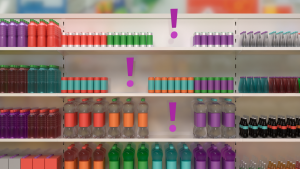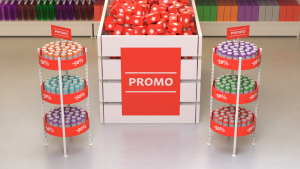Optimise your shelf: how to create the perfect shopping experience
By combining crowdsourcing and shelf optimization, we make your shelves transparent and profitable in 5 steps.
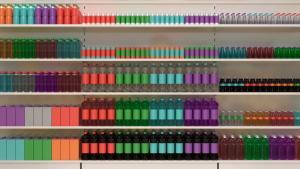
Satisfied customers, satisfied supplier, satisfied retailer
A well-designed shelf is the key to more satisfied customers and increased sales for both suppliers and retailers. Our partner, Hamilton Bright Trade Marketing, advises you on the perfect shelf layout, after which SmartSpotter maps whether this is being properly implemented in every store. Together with our partners, we offer a complete solution, from analysis to advice and implementation. This way, you get the most out of every square meter of shelf space.
The optimal shelf layout
Optimal shelf layouts ensure the right quantity of products are in the right place, presented to consumers at the right time with the right product information. These are the key requirements for optimal sales results and inventory management. Together with our partners, we ensure your shelves are perfectly presented.
The shelf is the only profitable touch point in the customer journey and plays a crucial role in your brand's presentation. The balance between product visibility and availability is crucial. Does the visibility of your product range meet shopper expectations? And does it generate impulse purchases? Does the shelf offer ideal inventory management, with a view to investing in inventory and preventing out-of-stock and overstock?
To illustrate the case, we'll use the Functional Foods category. This includes products with enhanced nutrients, such as protein bars, meal replacement shakes, and vitamin supplements.
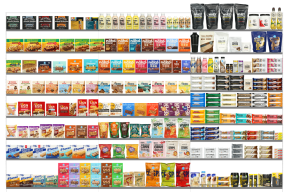
In 5 steps to a well-organized shelf
From gathering insights to taking concrete actions.
1. Visual optimization: the right layout for a better overview
Customers want to find products quickly, so good navigation is crucial. By logically segmenting products for example, within "Chocolate," separate bars, bonbons, and chocolates for sharing the decision-making process is shortened and the likelihood of impulse purchases increases. This in-store decision rate varies between 10% and 82%. For routine products like toilet paper, it's 10%, but for indulgent products like chips, it's a whopping 82%! Simply put, this means that 82% of the time, the choice for these types of products is made in-store. The more visible you are, the greater the chance that your brand will be chosen.
We map your shopper decision tree and design a perfect shelf with ideal navigation and segmentation. This forms the initial design for your shelf.
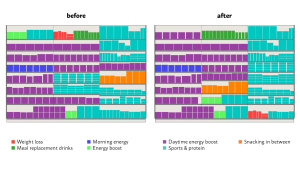
2. Availability: always the right products in stock
European research shows that the average out-of-stock percentage is around 9%. Do you know the out-of-stock percentage of your best-selling items? Prevent empty shelves during peak hours. Our advanced analytics allow us to determine whether sufficient space is available for each product. Too little space can lead to out-of-stock, while too much can result in losses. What you want is sufficient availability of your best-selling items, high-rotation products, and optimal space for products with lower rotation.
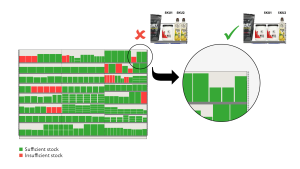
3. Financial optimisation: more turnover per meter
A smart shelf isn't just about convenience for the customer; it's also about profitability for both the retailer and the supplier. It's important for both sides that best-selling products get the best shelf position. The shopper decision tree is always considered when choosing that spot. This way, lower-rotating products are still effectively segmented. Products from the same brand, for example, remain on the same shelf.
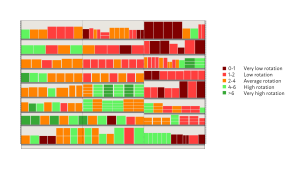
4. New proposal: from insight to action
We translate all the insights we gather above into a new shelf proposal, taking category management, market conditions, and the existing product range into account. The result is a shelf design that performs better and is future-proof. This will be discussed with you in detail afterward. The blueprint for your shelf is now complete; there's just one more step.
5. Clustering: the ideal shelf per location
Not every region or store has the same customer base. A store in the center of a large city is different from one in a small village. Based on purchasing behavior, demographics, and local preferences, the offering is perfectly tailored to the target group. The same applies to the store format; a very large supermarket, for example, requires a different approach than a small store at a petrol station.
Each formula also considers the number of shelves. This also influences the layout; a 3-meter shelf requires a different layout than a 2-meter shelf. By considering all these aspects, we ensure customised clustering.

Towards the perfect shelf
By combining crowdsourcing and shelf optimisation, we make your shelves transparent and profitable. You'll not only get a clear picture of your current shelf status, but also concrete improvement plans that can be implemented immediately. To close the loop, we also assess the implementation to ensure alignment with the proposed plans. This ensures satisfied customers and higher returns.

Want to optimise your shelf?
Feel free to send us a message

